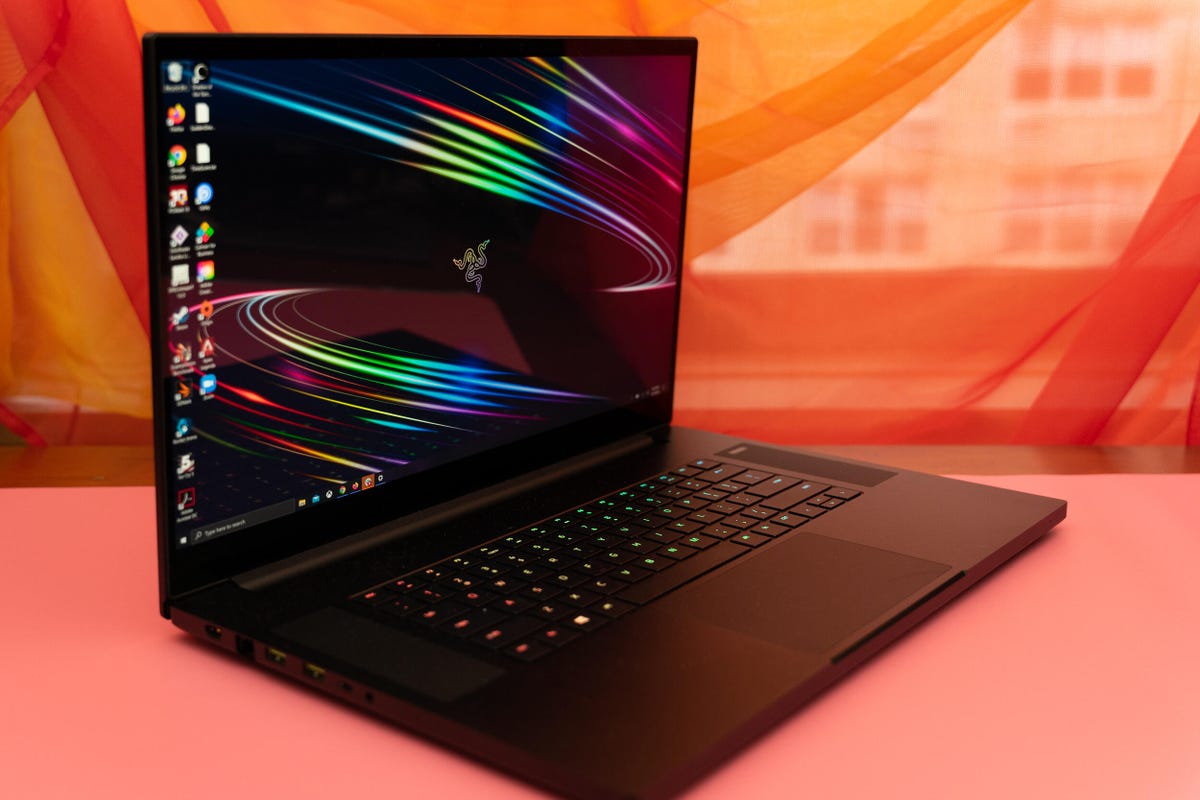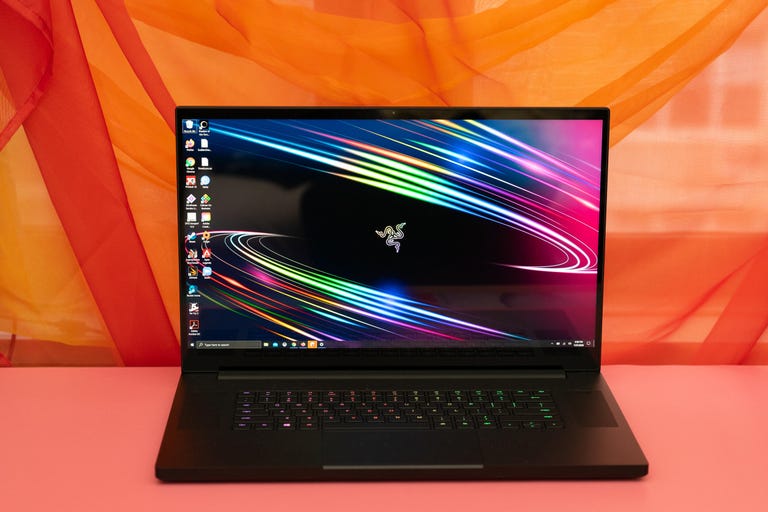 Why You Can Trust CNET
Why You Can Trust CNET Razer Blade Pro 17 review: A gaming laptop with photo editing on its mind
It's the typical well-rounded but expensive work-now-play-later laptop we've come to expect from the company.

The Blade Pro 17 deftly straddles the line between thin-and-light 17-inch general-purpose power models like the Dell XPS 17 9700 and hulking, steroidal gaming systems like the Acer Predator Helios 700 and Gigabyte Aorus 17x . While it may look like a Dark Side MacBook Pro 16, it's not really a competitor; it's much heavier and with far shorter battery life thanks to its more gaming-focused components. But its big, high-resolution color-accurate Adobe RGB screen and good performance in applications and games that use both the CPU and graphics processor for optimal performance -- think Shadow of the Tomb Raider, 3DS Max, Maya and so on -- and full set of connections make it particularly well suited for gaming, graphics and photo editing.
Like
- Fast, Adobe RGB-accurate 120Hz 4K display
- Classic Razer black slab design
- Complete set of connections
Don't like
- Prebuilt options limited to 16GB RAM
You won't be overwhelmed by options for this model. The current entry $2,900 model is 2019's, with a 240Hz Core i7-9750, GeForce RTX 2080 and 512GB SSD. That model has some potential deficiencies compared with the 2020 versions, including Intel AX200 wireless, which has I've had connectivity problems with and which was quickly replaced by the AX201, and no HDMI connection.
Razer retains connections many others have ditched, like HDMI, USB-A and Ethernet, and incorporates a 17.3-inch 120Hz 4K display.
That model also has the old keyboard, with the small right Shift key next to the arrow keys, a formula for many mistypes. I don't find the new one much better, though; I still reach too far down and hit the arrow keys. Nor am I a big fan of the half-height up and down arrows, but those are personal peeves that you may not care about.
Aside from the layout, I'm just not a big fan of the feel of Razer's keyboard. There isn't much travel but still seems to require more actuation force than I like for gaming -- and I'm not a light touch. The per-key RGB lighting is pretty, though.
This year's three options begin at $2,600 for a model with a 300Hz display, RTX 2070 Max-Q and 512GB SSD; $3,200 to up that to a 2080 Super Max-Q; and $3,800 for the latter with a 4K 120Hz touchscreen and a 1TB SSD, our evaluation configuration. Across the board they incorporate an eight-core Intel Core i7-10875H processor and 16GB RAM.
Razer Blade Pro 17 (early 2020)
| Price as reviewed | $3,799.99, £3699.99, AU$7,499 |
|---|---|
| Display size/resolution | 17.3-inch 3,840x2,160 120Hz 100% sRGB |
| PC CPU | Intel Core i7-10875H |
| PC memory | 16GB 3,233MHz DDR4 |
| Graphics | 8GB Nvidia GeForce RTX 2080 Super Max-Q |
| Storage | 1TB SSD, SD card slot |
| Ports | 2 x USB-C (1 x Thunderbolt 3), 3 x USB-A, 1 x HDMI, 1 x audio |
| Networking | Intel AX201 Wi-Fi 6 (802.11ax), Realtek 2.5GbE Ethernet, Bluetooth 5.0 |
| Operating system | Microsoft Windows Home (1909) |
| Weight | 6.1 lbs / 2.8 kg |
It's irritating that Razer only ships it in 16GB RAM configurations. On one hand, you can upgrade up to 64GB, and it's possibly cheaper to buy your own, but I really wish they'd offer a prebuilt 32GB choice for those of us who'd like something usable out of the box and that doesn't require dealing with about a dozen teeny tiny screws. Especially given the creator-gamer target market.
I do like the new 120Hz 4K 17.3-inch display, which uses a panel that you'll be seeing in a lot more gaming laptops this year. In addition to the speed, it's got a display that's beautifully calibrated for Adobe RGB, though less so -- but still good -- for other spaces like sRGB and P3. The one issue is that the profile's based on 100% brightness, which peaks at 441 nits, and if you need to work at the typical Adobe RGB 220-ish nits the color temperature gets warmer as the brightness falls.
The 2020 keyboard now has a mammoth right Shift key but pushes the arrow keys beneath it and shrinks the up and down arrows. I'm not sold on it.
The Blade Pro uses Nvidia 's Optimus technology, which gives laptops a split personality: It either maxes out the graphics processor or balances how it allocates power between that and the CPU, depending upon what you're doing. Unlike the newer Advanced Optimus, it still requires that you reboot between the two modes. Advanced requires a new system architecture so we've yet to see many laptops with it.
It matters here because Razer defaults to the discrete GPU mode, because in order to use the screen at 120Hz you need to. (Technically, the internal display has to be on the GPU bus, not the integrated graphics bus.) Most laptops that aren't designed to scream "GAMING!" default to Optimus mode. That means the Blade Pro will have meh battery life out of the box, and indeed ours lasted less than 3 hours in our pretty lightweight streaming video test.
As with most of the Optimus laptops I've tested, though, there's no clear distinction between which will give you better performance and when. It did deliver a whopping 20% better frame rate in Shadow of the Tomb Raider (in Optimus mode it averaged 88 frames per second versus 106fps on the GPU) and with improved latency, as well as a 48% increase in Maya and a 21% improvement over Optimus in SolidWorks (as measured by SPECviewperf 13). But for many other GPU-intensive operations the difference was insignificant or negligible.
Note that I didn't push it as high as it could probably go in GPU mode by bumping the fan speeds for both the CPU and GPU to their max. So, yes, I might have left some performance on the table. But the laptop never got as hot as I've experienced in the past, nor did it get very loud (although it would take a lot to drown out my air conditioner). So it's possible Razer leaves some performance on the table, too, to keep it running relatively cool and quiet.
Overall, however, it outpaced the Razer Blade 15 Advanced Studio Edition, with its Quadro RTX 5000 GPU, which makes it a nice alternative if you don't need certifications or the 16GB of graphics memory.
Though it's different in some ways, the design of the Blade Pro 17 is mostly the same as that of the rest of the Blades, with a look and feel that haven't changed in a while. The relatively austere, tanklike metal body remains. The screen bezels have gotten smaller, the ports have changed a bit and the heat venting has moved around, but ultimately it's the same pricey, well-balanced gaming-and-toiling workhorse we've come to appreciate.
Geekbench 5 (multicore)
Geekbench 5 (single-core)
Geekbench 5 (Vulkan)
Cinebench R20 CPU (multicore)
3DMark Fire Strike Ultra
Shadow of the Tomb Raider gaming test
3DMark Port Royal (RTX)
System configurations
| Acer Predator Helios 700 (PH717-71) | Microsoft Windows 10 Home (1909); 2.4GHz Intel Core i9-9980HK; 32GB DDR4 SDRAM 2,666MHz; 8GB Nvidia GeForce GTX 2080; 1TB SSD |
|---|---|
| Apple MacBook Pro 16 | Apple MacOS Catalina 10.15.1; 2.4GHz Intel Core i9-9980HK; 32GB DDR3 SDRAM 2,666MHz; 8GB Radeon Pro 5500M/1,536MB Intel HD Graphics 630; 2TB SSD |
| Asus ROG Strix Scar (G732LXS) | Microsoft Windows 10 Pro (2004); 2.4GHz Intel Core i9-10980HK; 32GB DDR4 SDRAM 3,233MHz; 8GB Nvidia GeForce GTX 2080 Super; 2TB SSD |
| Dell XPS 17 9700 | Microsoft Windows 10 Home (2004); 2.3GHz Intel Core i7-10875H; 32GB DDR4 SDRAM 3,233MHz; 6GB Nvidia GeForce RTX 2060 Max-Q; 1TB SSD |
| Gigabyte Aorus 17X | Microsoft Windows 10 Pro (1909); 2.4GHz Intel Core i9-10980HK; 32GB DDR4 SDRAM 3,233MHz; 8GB Nvidia GeForce RTX 2080 Super; 1TB SSD+2TB HDD |
| Razer Blade Pro 17 (early 2020) | Microsoft Windows 10 Home (1909); 2.3GHz Intel Core i7-10875H; 16GB DDR4 SDRAM 3,233MHz; 8GB Nvidia GeForce RTX 2080 Super Max-Q; 1TB SSD |


